#WebScrapingGroceryData
Explore tagged Tumblr posts
Text
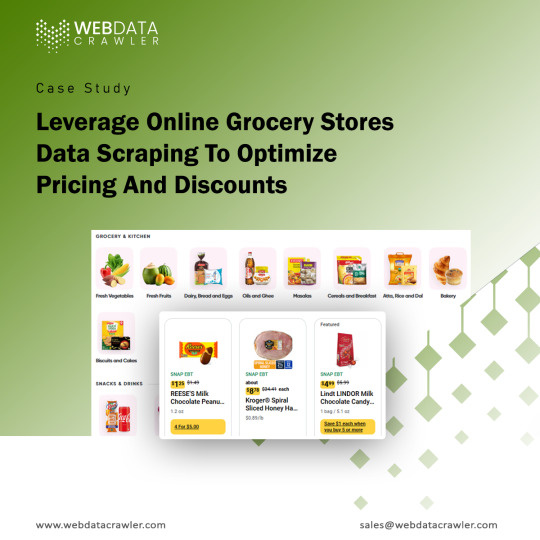
Leverage Online Grocery Stores Data Scraping To Optimize Pricing And Discounts Use Online Grocery Stores Data Scraping to track competitor prices, optimize discounts, and enhance pricing strategies for better sales and customer engagement. read more: https://www.webdatacrawler.com/online-grocery-stores-data-scraping-pricing-optimization.php
#OnlineGroceryStoresDataScraping#GroceryPriceMonitoring#OnlineGroceryPriceScraping#WebScrapingGroceryData#MRPScrapingServices#QuickCommerceDataScraping#GroceryDeliveryDataScraping#CompetitivePricingIntelligence#PriceTrackingSolutions#BigBasketDataScraping#ZeptoGroceryDeliveryDataScraping#JiomartDataExtractionServices#EcommercePriceMonitoring#RetailPriceOptimization#DynamicPricingStrategy
0 notes
Text

#WebScrapingGroceryStoreLocationData#ExtractSupermarketStoreLocationData#GroceryDeliveryAppDataCollection#WebScrapingGroceryPricesDataset#WebScrapingGroceryData#SupermarketDataScraper
0 notes
Text
How to Enhance Grocery Industry Expansion with Grocery Delivery Data Scraping?
Elevate grocery industry expansion with efficient grocery delivery data scraping techniques, optimizing strategies for growth and competitiveness.
#GroceryDeliveryDataScraping#GroceryDeliveryDataScraper#ExtractGroceryData#GroceryDataExtractor#WebScrapingGroceryData#ScrapeOnlineGroceryRetail
0 notes
Text

Introduction
In the evolving digital shopping world, consumers heavily depend on price comparisons to make well-informed purchasing choices. With grocery platforms such as Blinkit, Zepto, Instamart, and Big Basket offering varying price points for identical products, identifying the best deals can be complex.
This is where Web Scraping Techniques play a crucial role, automating the process of tracking and analyzing prices across multiple platforms. Whether you are a consumer seeking savings or a retailer evaluating competitor pricing, Web Scraping Grocery Data For Price Comparison provides a highly effective solution.
Why Compare Grocery Prices?
Comparing grocery prices across multiple platforms is essential for consumers and businesses to make informed purchasing decisions, stay competitive, and optimize costs.
Here's why it matters:
Cost Savings for Consumers
Business Competitive Analysis
Data-Driven Purchasing Decisions
Market Insights for Analysts
Challenges in Scraping Grocery Prices
Extracting Grocery Prices from online platforms presents multiple technical hurdles due to website complexities, anti-scraping measures, and frequent structural changes. Efficient solutions require adaptive techniques to ensure accuracy and scalability.
Dynamic Website Content
Anti-Scraping Measures
Frequent Website Updates
Scalability and Data Volume
Benefits of Web Scraping Grocery Data For Price Comparison
Web scraping grocery data provides businesses and consumers with real-time, accurate, and automated insights into price fluctuations across multiple platforms, enabling more intelligent purchasing and pricing strategies.
Track Grocery Prices In Real-Time
Saves Time and Effort
Data-Backed Decision Making
Historical Price Trends
Case Study: Web Scraping in Grocery Price Comparison
To showcase the effectiveness of Web Scraping Grocery Data For Price Comparison, we conducted a month-long study tracking grocery prices across multiple platforms.
1. Data Collection Process
A custom-built Grocery Prices Tracker was designed to extract essential pricing data, including product names, categories, prices, and discounts from leading grocery platforms:
Blinkit: Implemented BeautifulSoup and Selenium to handle JavaScript-rendered content efficiently.
Zepto: Utilized Selenium to extract grocery pricing data dynamically.
Instamart: Leveraged API requests and browser automation for seamless data retrieval.
Big Basket: Employed a combination of BeautifulSoup and Selenium to capture dynamically loaded content.
2. Key Findings
The analysis revealed critical insights into grocery pricing patterns across platforms:
Price Variability: Up to 15% price difference was observed for everyday grocery items across different platforms.
Discount Trends: Big Basket maintained consistent discounts, while Blinkit frequently introduced flash sales, influencing short-term pricing dynamics.
Hidden Charges: Additional costs, particularly delivery fees, played a major role in determining consumers' final purchase price.
Best Savings: Over one month, Zepto emerged as the most cost-effective platform for grocery shopping.
3. Business Applications
The extracted insights offer valuable applications for various stakeholders:
Retailers: Optimize pricing strategies based on real-time competitive data.
Consumers: Make informed decisions by identifying the most budget-friendly grocery platform.
Market Analysts: Track Grocery Prices and emerging trends across Blinkit, Zepto, Instamart, and Big Basket, enabling data-driven market predictions.
This analysis provides a data-backed approach to understanding grocery pricing strategies, offering actionable insights for businesses and consumers.
Key Tools & Technologies for Grocery Price Scraping
Developing a robust Grocery Price Comparison system requires a well-structured approach and the correct set of tools. Below are the key tools & technologies that play a crucial role in ensuring accurate and efficient data extraction:
Python: Serves as the core programming language for automating the web scraping process and handling data extraction efficiently.
BeautifulSoup: A widely used library that facilitates parsing HTML and XML documents, enabling seamless data retrieval from web pages.
Scrapy: A high-performance web scraping framework that provides structured crawling, data processing, and storage capabilities for large-scale scraping projects.
Selenium: Essential for scraping websites that rely heavily on JavaScript by simulating human interactions and extracting dynamically loaded content.
Proxies & VPNs: Helps maintain anonymity and prevent IP bans when scraping large-scale data across multiple sources.
Headless Browsers: Enables automated interaction with dynamic websites while optimizing resource usage by running browsers without a graphical interface.
Businesses can efficiently extract and compare grocery pricing data by leveraging these technologies, ensuring competitive market insights and informed decision-making.
Step-by-Step Guide to Scraping Grocery Prices
A Step-by-Step Guide to Scraping Grocery Prices provides a structured approach to extracting pricing data from various online grocery platforms. This process involves selecting the appropriate tools, handling dynamic content, and storing the extracted information in a structured format for analysis.
1. Scraping Blinkit Grocery Prices
Identify the product categories and corresponding URLs for targeted scraping.
Utilize BeautifulSoup for static web pages or Selenium to handle interactive elements.
Manage AJAX requests to extract dynamically loaded content effectively.
Store the extracted data in CSV, JSON, or a database for easy access and analysis.
2. Extracting Zepto Grocery Prices
Leverage Selenium to interact with webpage elements and navigate through the website.
Implement wait times to ensure content is fully loaded before extraction.
Structure the extracted data efficiently, including product names, prices, and other key attributes.
3. Scraping Instamart Grocery Prices
Use Selenium to manage dynamically changing elements.
Extract product names, prices, and discount information systematically.
Implement headless browsers to enable large-scale automation while minimizing resource consumption.
4. Web Scraping Big Basket Grocery Prices
Apply BeautifulSoup to extract data from static pages efficiently.
Utilize Selenium to handle dynamically loaded product details.
Store and organize extracted product information in a structured manner for further processing.
This guide provides a comprehensive roadmap for efficiently scraping grocery price data from various platforms, ensuring accuracy and scalability in data collection.
Automating the Process
To ensure continuous Track Grocery Prices In Real-Time, use automation techniques like cron jobs (Linux) or task schedulers (Windows).# Run scraper every 6 hours 0 */6 * * * /usr/bin/python3 /path_to_script.py
Conclusion
In today’s fast-paced digital marketplace, Web Scraping Grocery Data For Price Comparison is essential for making informed purchasing and pricing decisions. Automating data extraction allows businesses and consumers to analyze price variations across multiple platforms without manual effort.
With accurate Grocery Price Comparison, shoppers can maximize savings, while retailers can adjust their pricing strategies to stay ahead of competitors. Real-time insights into pricing trends allow businesses to respond quickly to market fluctuations and promotional opportunities.
We offer advanced solutions for Scraping Grocery Prices, ensuring seamless data collection and analysis. Whether you need a custom scraper or large-scale price monitoring, our expertise can help you stay competitive. Contact Retail Scrape today to implement a powerful grocery price-tracking solution!
Source :https://www.retailscrape.com/automate-web-scraping-grocery-data-for-price-comparison.php
Originally Published By https://www.retailscrape.com/
#WebScrapingTechniques#PriceComparisonThroughWebScraping#WebScrapingGroceryData#GroceryPriceComparison#AutomatedPriceTracking#OnlineGroceryDataExtraction#RealTimePriceMonitoring#GroceryMarketAnalytics#CompetitivePricingAnalysis#RetailDataScraping#GroceryEcommerceInsights#ZeptoPriceData#BlinkitDataScraping#BigBasketPriceComparison#InstamartPricingIntelligence#AutomatedDataExtractionTools#GroceryProductDataCollection#DynamicPricingStrategy#APIBasedPriceScraping#DataAutomationForRetail#GroceryIndustryTrends#PriceOptimizationUsingData#ConsumerPricingIntelligence
0 notes
Text
Leverage Web Scraping Service for Grocery Store Location Data

Why Should Retailers Invest in a Web Scraping Service for Grocery Store Location Data?
In today's digital-first world, web scraping has become a powerful tool for businesses seeking to make data-driven decisions. The grocery industry is no exception. Retailers, competitors, and market analysts leverage web scraping to access critical data points like product listings, pricing trends, and store-specific insights. This data is crucial for optimizing operations, enhancing marketing strategies, and staying competitive. This article will explore the significance of web scraping grocery data, focusing on three critical areas: product information, pricing insights, and store-level data from major retailers.
By using Web Scraping Service for Grocery Store Location Data, businesses can also gain geographical insights, particularly valuable for expanding operations or analyzing competitor performance. Additionally, companies specializing in Grocery Store Location Data Scraping Services help retailers collect and analyze store-level data, enabling them to optimize inventory distribution, track regional pricing variations, and tailor their marketing efforts based on specific locations.
The Importance of Web Scraping in Grocery Retail
The grocery retail landscape is increasingly dynamic, influenced by evolving consumer demands, market competition, and technological innovations. Traditional methods of gathering data, such as surveys and manual research, are insufficient in providing real-time, large-scale insights. Scrape Grocery Store Locations Data to automate the data collection, enabling access to accurate, up-to-date information from multiple sources. This enables decision-makers to react swiftly to changes in the market.
Moreover, grocery e-commerce platforms such as Walmart, Instacart, and Amazon Fresh host vast datasets that, when scraped and analyzed, reveal significant trends and opportunities. This benefits retailers and suppliers seeking to align their strategies with consumer preferences and competitive pricing dynamics. Extract Supermarket Store Location Data to gain insights into geographical performance, allowing businesses to refine store-level strategies better and meet local consumer demands.
Grocery Product Data Scraping: Understanding What's Available
At the heart of the grocery shopping experience is the product assortment. Grocery Delivery App Data Collection focuses on gathering detailed information about the items that retailers offer online. This data can include:
Product Names and Descriptions: Extracting Supermarket Price Data can capture product names, detailed descriptions, and specifications such as ingredients, nutritional information, and packaging sizes. This data is essential for companies involved in product comparison or competitive analysis.
Category and Subcategory Information: By scraping product categories and subcategories, businesses can better understand how a retailer structures its product offerings. This can reveal insights into the breadth of a retailer's assortment and emerging product categories that may be gaining traction with consumers, made possible through a Web Scraping Grocery Prices Dataset.
Brand Information: Scraping product listings also allows businesses to track brand presence and popularity across retailers. For example, analyzing the share of shelf space allocated to private label brands versus national brands provides insights into a retailer's pricing and promotional strategies using a Grocery delivery App Data Scraper.
Product Availability: Monitoring which products are in or out of stock is a critical use case for grocery data scraping. Real-time product availability data can be used to optimize inventory management and anticipate potential shortages or surpluses. Furthermore, it allows retailers to gauge competitor stock levels and adjust their offerings accordingly through a Grocery delivery App data scraping api.
New Product Launches: Scraping data on new product listings across multiple retailers provides insights into market trends and innovation. This is particularly useful for suppliers looking to stay ahead of the competition by identifying popular products early on or tracking how their new products are performing across various platforms.
Scraping Grocery Data for Pricing Insights: The Competitive Advantage
Pricing is arguably the most dynamic and critical component of the grocery industry. Prices fluctuate frequently due to promotions, competitor actions, supply chain constraints, and consumer demand shifts. Web scraping enables businesses to monitor real-time pricing data from major grocery retailers, providing several key advantages:
Price Monitoring Across Retailers: Scraping pricing data from different retailers allows businesses to compare how similar products are priced in the market. This information can be used to adjust pricing strategies, ensure competitiveness, and maximize profit margins. Retailers can quickly react to competitor price changes and optimize their promotional activities to attract price-sensitive customers.
Dynamic Pricing Strategies: Businesses can implement dynamic pricing strategies with access to real-time pricing data. For instance, if a competitor lowers the price of a particular product, a retailer can respond by adjusting its prices in near real-time. This level of responsiveness helps maintain market competitiveness while protecting margins.
Tracking Promotions and Discounts: Businesses can identify ongoing or upcoming sales events by scraping promotional and discount data. This is particularly useful for analyzing the frequency and depth of discounts, which can help retailers and suppliers evaluate the effectiveness of their promotional campaigns. Moreover, tracking promotional patterns can provide insights into seasonal or event-based price adjustments.
Historical Pricing Trends: Web scraping tools can be configured to collect and store historical pricing data, allowing businesses to analyze long-term trends. This historical data is valuable for forecasting future pricing strategies, assessing the impact of inflation, and predicting market trends.
Price Elasticity Analysis: By combining pricing data with sales data, businesses can conduct price elasticity analysis to understand how sensitive consumer demand is to price changes. This information can help retailers set optimal prices that balance consumer expectations with profitability.
Understanding Store-Level Insights Using Scraped Grocery Data
Grocery retailers often have multiple locations, and the dynamics at each store can vary significantly based on factors like local demand, competition, and supply chain logistics. Web scraping can provide valuable store-level insights by collecting data on:
Store Locations and Hours: Scraping data on store locations, hours of operation, and services offered (such as delivery or curbside pickup) helps businesses assess a retailer's geographical reach and operational strategies. This is particularly useful for competitors analyzing potential areas for expansion or companies offering location- based services.
Geographical Pricing Variations: Pricing can vary significantly across regions due to local supply and demand differences, transportation costs, and regional promotional strategies. Web scraping allows businesses to track how prices differ across geographical locations, providing valuable insights for retailers or suppliers operating in multiple markets.
Inventory Levels and Replenishment Patterns: By scraping data on product availability at different store locations, businesses can gain insights into local inventory levels and replenishment patterns. For instance, certain stores may frequently run out of stock for popular items, signaling supply chain inefficiencies or increased local demand. This information can be used to optimize logistics and improve customer satisfaction.
Localized Promotions and Discounts: Retailers often run location-specific promotions, especially during events or holidays. Scraping data on localized promotional activities allows businesses to identify regional marketing strategies and understand how retailers target specific customer segments.
Competitor Store Performance: Analyzing store-level data from competitors can provide critical insights into their operational performance. For example, frequent stockouts or changes in store hours might indicate logistical challenges, while new store openings could signal an expansion strategy.
Scraping Data from Major Grocery Retailers for Data-Driven Decisions
Scraping grocery data from several major grocery retailers, including Walmart, Kroger, and Amazon Fresh, helps gather critical data for making informed decisions.
Walmart: As one of the largest grocery retailers in the world, Walmart is known for its wide range of products. Businesses can employ sophisticated data collection techniques to monitor competitor pricing, analyze product assortment trends, and optimize inventory management. Walmart's expansive product catalog and broad geographical reach make it a valuable data source for competitors and market analysts.
Kroger: Kroger is a leader in data analytics and enhancing the customer experience. By scraping data from its online platform and competitors, businesses can identify trends in consumer preferences, optimize pricing strategies, and improve product availability across their stores.
Amazon Fresh: Amazon Fresh is a digital-first grocery platform popular for delivery. Businesses can extensively use web scraping to monitor pricing and product trends in real-time. Knowing Amazon's dynamic pricing strategies, businesses can adjust theirs based on competitor prices and demand fluctuations.
Instacart: Instacart partners with various grocery retailers, and its platform serves as a hub for scraping data on product availability, pricing, and promotions from multiple stores. This data is valuable for market analysts and competitors, providing insights into regional pricing trends and consumer preferences.
Tesco: In the UK, Tesco has extensive data on products, pricing, delivery, etc. Businesses can leverage data extraction processes to collect data on grocery items. This helps them refine their product offerings and pricing strategies to remain competitive in a highly saturated market.
The Future of Web Scraping in Grocery Retail
Web scraping is poised to become even more critical as the grocery industry evolves. The rise of e-commerce grocery platforms and the increasing consumer demand for real-time, personalized shopping experiences will only amplify the need for accurate and comprehensive data. Several emerging trends are expected to shape the future of web scraping in grocery retail:
Artificial Intelligence (AI) and Machine Learning (ML) Integration: AI and ML technologies will be increasingly used to enhance web scraping capabilities. These technologies can help businesses identify patterns in large datasets, predict future trends, and make more informed pricing and product assortment decisions.
Voice-Enabled Shopping Insights: As voice search becomes more prevalent, grocery retailers may use web scraping to analyze voice-enabled shopping queries. This data can provide insights into how consumers interact with digital assistants and inform strategies for optimizing voice-based search functionality.
Increased Focus on Data Privacy: As governments worldwide introduce stricter data privacy regulations, businesses engaged in web scraping will need to ensure compliance. This will likely result in more sophisticated data anonymization techniques and a greater emphasis on responsible data collection practices.
Real-Time Personalization: As consumer expectations for personalized shopping experiences grow, web scraping will deliver real-time, individualized recommendations. By analyzing a customer's purchases, preferences, and browsing history, retailers can offer tailored product suggestions and promotions.
Conclusion
Web Scraping Service for Grocery Store Location Data is a game-changing tool for retailers, suppliers, and market analysts seeking a competitive edge. By automating the collection of product, pricing, and store-level data, businesses can unlock a wealth of insights that drive more intelligent decision-making. Whether it's monitoring product availability, adjusting pricing strategies, or understanding geographical differences in in-store performance, web scraping offers an unparalleled opportunity to stay ahead in the fast-paced world of grocery retail. As the industry continues to evolve, web scraping will remain a critical tool for harnessing the power of data to shape the future of grocery shopping.
Experience top-notch web scraping service and mobile app scraping solutions with iWeb Data Scraping. Our skilled team excels in extracting various data sets, including retail store locations and beyond. Connect with us today to learn how our customized services can address your unique project needs, delivering the highest efficiency and dependability for all your data requirements.
Source: https://www.iwebdatascraping.com/leverage-web-scraping-service-for-grocery-store-location-data.php
#WebScrapingGroceryStoreLocationData#ExtractSupermarketStoreLocationData#GroceryDeliveryAppDataCollection#WebScrapingGroceryPricesDataset#WebScrapingGroceryData#SupermarketDataScraper
0 notes
Text
#WebScrapingGroceryStoreLocationData#ExtractSupermarketStoreLocationData#GroceryDeliveryAppDataCollection#WebScrapingGroceryPricesDataset#WebScrapingGroceryData#SupermarketDataScraper
0 notes
Text

Our AI Analytics optimized pricing for 200 stores. Grocery data scraping streamlined operations, boosting profitability with strategic pricing adjustments.
Know more: https://www.iwebdatascraping.com/grocery-data-scraping-achieve-accuracy-across-stores.php
#GroceryDataScraping#GroceryDataScraper#ScrapeGroceryData#WebScrapingGroceryData#ExtractGroceryData#GroceryDataCollection
0 notes
Text
How Did Our Grocery Data Scraping Achieve 99% Accuracy Across 200 Stores?

How Did Our Grocery Data Scraping Achieve 99% Accuracy Across 200 Stores?
This case study showcases the effectiveness of our AI Analytics in optimizing pricing across 200 stores. Leveraging our grocery data scraping services, we streamlined operations and enhanced profitability through strategic pricing adjustments.
Get Started Now
The Client
A Leading USA Based Grocery Retailer
iWeb Data Scraping Offerings: Utilize data crawling services to scrape grocery data for pricing optimization
Client's Challenge:
The client needed help accurately matching products with competitor offerings and tracking prices across various zip codes. Particularly daunting was comparing prices for fresh produce and non-branded SKUs. Additionally, monitoring competitor discounts and promotions posed a significant challenge. Implementing a grocery data scraper was imperative to overcome these obstacles. With it, the client could maintain competitiveness and market relevance. The scraper's ability to efficiently gather data on similar products and pricing variations across regions addressed these challenges head-on, empowering the client to make informed pricing decisions and stay abreast of competitor activities in the dynamic grocery landscape.
Our Solutions: Grocer Data Scraping
With our grocery data scraping, we achieved an impressive 99% accuracy in streamlining pricing data across 200 stores. This precision empowered the client to optimize their pricing strategies effectively, ensuring competitiveness and maximizing profitability. By eliminating inaccuracies and discrepancies in pricing information, our solution enabled the client to make informed decisions swiftly, maintaining a solid market position amidst fierce competition. With real-time insights into competitor pricing and promotional activities, the client could adapt dynamically, capitalizing on emerging trends and opportunities. Ultimately, our partnership improved operational efficiency and strategic agility, positioning the client for sustained success in the ever-evolving grocery retail landscape.
Web Scraping Advantages
Accurate Pricing Insights: You can gain access to precise pricing data across a wide range of stores and products, ensuring informed decision-making and competitive pricing strategies.
Comprehensive Competitor Analysis: Stay ahead by leveraging our grocery data scraper to monitor competitor pricing, discounts, and promotions, enabling proactive adjustments to your strategies.
Streamlined Operations: Our services streamline the process of matching products against competitors and tracking prices across multiple zip codes, saving your business time and resources.
Enhanced Product Positioning: Identify opportunities for product differentiation and optimization, especially in challenging categories like fresh produce and non-branded SKUs, to better meet customer demands.
Improved Profitability: Our 99% accuracy in pricing data allows you to optimize pricing strategies effectively, maximizing profitability and ensuring sustained success in the competitive grocery market.
Know more: https://www.iwebdatascraping.com/grocery-data-scraping-achieve-accuracy-across-stores.php
#GroceryDataScraping#GroceryDataScraper#ScrapeGroceryData#WebScrapingGroceryData#ExtractGroceryData#GroceryDataCollection
0 notes
Text
How Did Our Grocery Data Scraping Achieve 99% Accuracy Across 200 Stores?
Our AI Analytics optimized pricing for 200 stores. Grocery data scraping streamlined operations, boosting profitability with strategic pricing adjustments.
Know more: https://www.iwebdatascraping.com/grocery-data-scraping-achieve-accuracy-across-stores.php
#GroceryDataScraping#GroceryDataScraper#ScrapeGroceryData#WebScrapingGroceryData#ExtractGroceryData#GroceryDataCollection
0 notes
Text

How Can Scraping Price Data from Swiggy Instamart, Zepto, and Blinkit Enhance Your Business Strategy?
Scraping price data from Swiggy Instamart, Zepto, and Blinkit enables businesses to stay competitive and make informed decisions.
Know more: https://www.iwebdatascraping.com/scraping-price-data-from-swiggy-instamart-zepto-and-blinkit.php
#ScrapingPriceDataFromSwiggy#ScrapingPriceDataFromInstamart#ScrapingPriceDataFromZepto#ScrapingPriceDataFromBlinkit#GroceryDataScraper#WebScrapingGroceryData
0 notes
Text
How Can Scraping Price Data from Swiggy Instamart, Zepto, and Blinkit Enhance Your Business Strategy?

How Can Scraping Price Data From Swiggy Instamart, Zepto, And Blinkit Enhance Your Business Strategy?
Grocery price data scraping involves collecting pricing information from online grocery platforms like Swiggy Instamart, Zepto, and Blinkit. This process is crucial for businesses to stay competitive by understanding market trends and setting competitive prices.
Techniques are used to scrape grocery price data, collecting information such as product names, prices, and descriptions from these platforms' websites. This data can then be analyzed to understand pricing strategies, monitor competitor prices, and optimize pricing strategies.
However, it's important to note that scraping price data from swiggy installment, Zepto, and blinkit should be done ethically and in compliance with the platforms' terms of service. Data accuracy and consistency are vital considerations when scraping grocery price data, as inaccuracies can lead to incorrect pricing decisions.
About Swiggy Instamart, Zepto, Blinkit
Swiggy Instamart is an online grocery delivery platform by Swiggy that offers a wide range of groceries, including fresh produce, dairy, and pantry staples. It provides quick delivery and a user-friendly interface for convenient shopping. Scraping Swiggy Instamart's grocery price data involves extracting information on product prices, descriptions, and availability to analyze market trends and competitor pricing strategies.
Zepto is an online grocery platform known for its wide selection of products and reliable delivery services. Scraping Zepto's grocery price data involves extracting details like product prices, descriptions, and availability. This data can be analyzed to understand consumer preferences and market trends, enabling businesses to make informed pricing and marketing decisions.
Blinkit, formerly Grofers, is an online grocery delivery service known for its affordable prices and extensive product range. Scraping Blinkit's grocery price data involves extracting product prices, descriptions, and availability information. Analyzing this data can provide insights into pricing strategies and consumer behavior, helping businesses stay competitive in the online grocery market.
Why Extract Price Information from Swiggy Instamart, Zepto, Blinkit
Extracting price information from platforms like Swiggy Instamart, Zepto, and Blinkit offers several significant advantages:
Competitive Pricing Strategies: Price data allows businesses to analyze competitor pricing strategies. By understanding how competitors price their products, businesses can adjust their prices to remain competitive.
Market Trends and Consumer Behavior: Price data provides insights into market trends and consumer behavior. Businesses can identify high-demand products and adjust their pricing and marketing strategies accordingly.
Optimized Product Pricing: Analyzing price data helps businesses optimize their pricing strategies. Businesses can determine the optimal price points that maximize revenue and profitability by analyzing price elasticity.
Dynamic Pricing: Price data enables businesses to implement dynamic pricing strategies. Businesses can adjust prices based on demand, competition, and inventory levels by analyzing real-time price data.
Promotional Strategies: Price data can help businesses plan and implement promotional strategies. Businesses can determine the most effective times to offer discounts and promotions to drive sales by analyzing pricing trends.
Consumer Benefits: Price data also gives consumers transparency and the ability to compare prices across different platforms. It helps consumers decide where to shop based on price, quality, and convenience.
Role of Advanced Grocery Data Scraping Services
Advanced grocery data scraping services are pivotal in the modern retail ecosystem, particularly in the online grocery sector. These services leverage cutting-edge technologies and algorithms to extract, process, and analyze large volumes of data from various online grocery platforms such as Swiggy Instamart, Zepto, and Blinkit.
One of the critical roles of these services is in competitor analysis. By scraping and analyzing competitor pricing and product data, businesses can gain valuable insights into their competitors' strategies and market positioning. This information can be used to adjust their pricing, product assortment, and promotional strategies to stay competitive.
Moreover, advanced grocery data scraping services enable businesses to identify market trends and consumer preferences. Businesses can make data-driven decisions regarding inventory management, product development, and marketing campaigns by analyzing shopping patterns and purchase behaviors.
Additionally, these services play a crucial role in price optimization. By analyzing pricing data and market dynamics, businesses can set optimal prices that maximize revenue and profitability while remaining competitive.
Overall, advanced grocery data scraping services are indispensable tools for businesses looking to thrive in the highly competitive online grocery market. They provide them with actionable insights and a competitive edge.
Conclusion: Extracting price information from online grocery platforms like Swiggy Instamart, Zepto, and Blinkit is essential for businesses to stay competitive and meet consumer demands effectively. Businesses can gain valuable insights into competitor strategies, market trends, and consumer behavior by analyzing pricing data from these platforms. This information enables businesses to optimize pricing strategies, tailor product offerings, and plan effective promotional campaigns. Ultimately, extracting price information from these platforms empowers businesses to make informed decisions that drive growth and success in the dynamic and highly competitive online grocery market.
Discover unparalleled web scraping service or mobile app data scraping offered by iWeb Data Scraping. Our expert team specializes in diverse data sets, including retail store locations data scraping and more. Reach out to us today to explore how we can tailor our services to meet your project requirements, ensuring optimal efficiency and reliability for your data needs.
Know more: https://www.iwebdatascraping.com/scraping-price-data-from-swiggy-instamart-zepto-and-blinkit.php
#ScrapingPriceDataFromSwiggy#ScrapingPriceDataFromInstamart#ScrapingPriceDataFromZepto#ScrapingPriceDataFromBlinkit#GroceryDataScraper#WebScrapingGroceryData
0 notes
Text
How Can Scraping Price Data from Swiggy Instamart, Zepto, and Blinkit Enhance Your Business Strategy?
Scraping price data from Swiggy Instamart, Zepto, and Blinkit enables businesses to stay competitive and make informed decisions.
Read more: https://www.iwebdatascraping.com/scraping-price-data-from-swiggy-instamart-zepto-and-blinkit.php
#ScrapingPriceDataFromSwiggy#ScrapingPriceDataFromInstamart#ScrapingPriceDataFromZepto#ScrapingPriceDataFromBlinkit#GroceryDataScraper#WebScrapingGroceryData
0 notes
Text
How to Enhance Grocery Industry Expansion with Grocery Delivery Data Scraping?

The rise of online grocery delivery platforms has transformed how people shop for groceries, eliminating the need for weekly visits to physical stores. This industry witnesses significant growth, with a projected annual revenue increase of 20% from 2021 to 2031. Popular websites and apps such as DoorDash, Amazon Fresh, and InstaCart have experienced a surge in orders.
Online grocery delivery services have thrived thanks to advancements in digital technology, robust logistics, and increasingly hectic personal and professional lives. For those looking to expand existing services or embark on a new venture, web scraping grocery data emerges as a powerful solution to help achieve their business objectives.
Online grocery shopping has become an essential user service in today's fast-paced world. Customers no longer need to visit physical stores to browse products, as their time is increasingly limited. The growing demand for convenience is propelling the online grocery market forward. By 2022, roughly 10% of all grocery sales will occur online, amounting to a staggering $133.8 billion in value.
List Of Data Fields
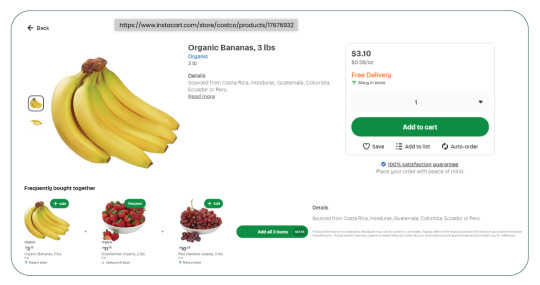
Product Full Name
Product SKU/Code
Image Product URL
Category of Product
Subcategories
Product Price
Discounted Price
Product Savings
Cost of Shipping
Description of Product
Specification of Product
Details Seller
Best Deals on Popular Products
Offer Best
Sellers Best
Offers Combo
Why Scrape Grocery Delivery Data?
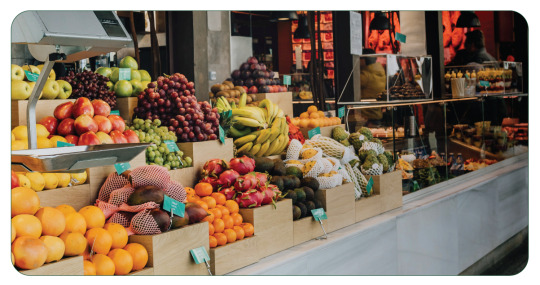
Scraping grocery delivery data offers numerous benefits for businesses and consumers:
Competitive Analysis: It allows businesses to gather competitors' data and analyze their pricing strategies, product offerings, and delivery services to gain a competitive edge.
Pricing Optimization: By scraping pricing data from various grocery delivery services, businesses can make informed pricing decisions to attract and retain customers.
Product Availability: Monitoring product availability and stock levels helps businesses meet customer demand and avoid stockouts.
Market Trends: Scrape grocery delivery data to provide insights into market trends, helping businesses adapt to changing consumer preferences and emerging product categories.
Customer Convenience: Consumers can use scraped data to compare grocery delivery options, find the best deals, and streamline their shopping experience, ultimately saving time and money.
How Can Grocery Data Scraping Help Enhance Business Success?

Grocery delivery data scraping is a potent catalyst for business success in the ever-evolving world of online grocery retail. Aggregating data from various sources equips businesses with the intelligence to make informed decisions that drive growth and competitiveness. It offers a competitive advantage by providing insights into pricing strategies, product assortments, and service offerings of rivals. Real-time pricing data enables businesses to optimize pricing strategies, attracting and retaining customers while ensuring profitability. Monitoring product availability and stock levels minimizes the risk of stockouts, ensuring a seamless customer experience. Insights into market trends and consumer preferences help businesses adapt staying ahead of changing demands. In addition, customer behavior analysis allows for tailored services, ultimately boosting customer satisfaction. Automating data collection using grocery data scraper saves time and resources, directing efforts toward strategic planning and operational efficiency. Whether expanding into new regions or diversifying product lines, grocery data scraping services empower businesses to make data-driven choices and enhance their prospects of success in the dynamic grocery sector. Web scraping grocery delivery data is a versatile tool with various applications, benefiting many stakeholders in the rapidly growing online grocery market. Whether you are an established grocery retailer, an online merchant, a bulk grocery dealer, a competitor in the grocery platform sector, or a business planning expansion, web scraping provides unique advantages:
Grocery Retailers: If you currently operate a brick-and-mortar grocery business, transitioning to an online model can provide customers with enhanced convenience. To ensure a successful transition, analyzing local competitors' offerings is crucial. Web scraping services can help you gain insights into local grocers' products, pricing, and strategies. This data can guide your marketing efforts and ensure a competitive edge when joining popular grocery delivery platforms.
Online Retailers: Incorporating groceries can boost sales and revenue for online retailers offering products across various categories. High-quality grocery items can attract a broader customer base, increasing sales in other product categories. Web scraping allows you to identify the most appealing grocery products and refine your offerings accordingly.
Bulk Grocery Dealers: If you are a bulk grocery dealer catering to retailers, web scraping can provide invaluable insights into customer preferences. Collecting data from product ratings and reviews can comprehensively understand popular product categories across different regions. This information helps you tailor your offerings to attract more retailers seeking bulk grocery supplies.
Grocery Platform Competitors: In an industry with regular new entrants, staying competitive is essential. Web scraping can significantly enhance your business strategy if you operate or plan to launch an online grocery platform. By scraping data from competitor platforms, you can gather critical insights into market dynamics, best-selling products, pricing strategies, and more. This valuable information gives your business a substantial competitive advantage.
Business Expansion: Expanding your grocery delivery services to new cities or regions requires thorough market research. A customized web scraping solution is instrumental in this process. By leveraging location-specific data, you can gain a detailed overview of existing grocery delivery services and sellers in the target area. This information allows you to align your expansion plans with local market expectations and requirements, increasing your chances of success.
Use Cases Of Grocery Delivery Data Scraping
Extracting grocery delivery data can offer consumers and businesses a wide range of valuable use cases. Here are these use cases explained in more detail:
Price Comparison: Grocery delivery data can be scraped from various sources to compare the prices of different products across multiple online retailers or local stores. It enables consumers to find the most cost-effective options for their groceries.
Product Research: Scraping data from grocery websites provides detailed information about grocery products, such as descriptions, nutritional facts, customer reviews, and ratings. This information empowers consumers to decide which products to buy, considering factors like quality and suitability for their needs.
Stock Availability: Consumers can scrape grocery data to check the real-time stock availability of products. It helps prevent disappointment by ensuring that the desired items are in stock before placing an order, which is particularly important for popular or seasonal items.
Shopping List Creation: Using scraped data, consumers can create customized shopping lists. They can browse available products, add them to their lists, and plan their grocery shopping more efficiently, ensuring they remember all essential items.
Price Tracking: Scraped data allows consumers to track price changes. It enables them to identify price drops, discounts, and the optimal time to purchase, saving money.
Market Analysis: For businesses, scraping grocery delivery data provides valuable insights into market trends, popular products, and customer preferences. This information is crucial for making strategic decisions and adjustments to meet market demands effectively.
Personalized Recommendations: Using scraped data, businesses, and online grocery platforms can offer personalized product recommendations to customers. These recommendations are based on individual preferences, past purchase history, and browsing behavior, enhancing the shopping experience.
Promotions and Marketing: Businesses can use scraped data to identify marketing opportunities and promotional strategies. This data helps target specific customer segments effectively and create marketing campaigns that resonate with their audience.
At Product Data Scrape, we maintain the highest ethical standards in all operations, including Competitor Price Monitoring and Mobile App Data Scraping. With a global presence spanning multiple offices, we consistently deliver exceptional and honest services to meet the diverse needs of our valued customers.
#GroceryDeliveryDataScraping#ScrapeGroceryDeliveryData#WebScrapingGroceryData#OnlineGroceryRetailScraping#GroceryDeliveryDataExtraction#ExtractGroceryDeliveryData#ScrapeGroceryDelivery
0 notes
Text
How to Enhance Grocery Industry Expansion with Grocery Delivery Data Scraping?
Elevate grocery industry expansion with efficient grocery delivery data scraping techniques, optimizing strategies for growth and competitiveness.
#GroceryDeliveryDataScraping#ScrapeGroceryDeliveryData#WebScrapingGroceryData#OnlineGroceryRetailScraping#GroceryDeliveryDataExtraction#ExtractGroceryDeliveryData#ScrapeGroceryDelivery
0 notes
Text
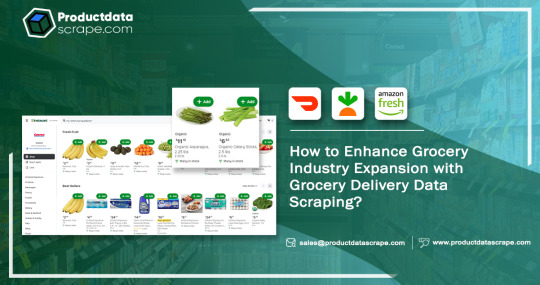
How to Enhance Grocery Industry Expansion with Grocery Delivery Data Scraping?
#GroceryDeliveryDataScraping#WebScrapingGroceryData#GroceryDataScraper#GroceryDataExtraction#ScrapeGroceryDeliveryData
0 notes
Text
How to Enhance Grocery Industry Expansion with Grocery Delivery Data Scraping?
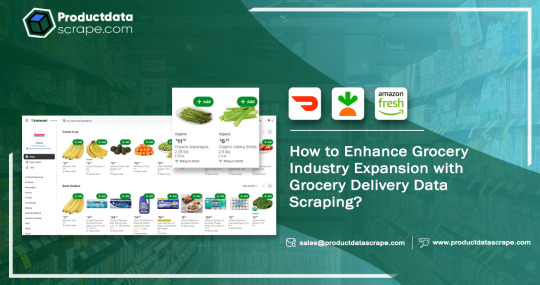
The rise of online grocery delivery platforms has transformed how people shop for groceries, eliminating the need for weekly visits to physical stores. This industry witnesses significant growth, with a projected annual revenue increase of 20% from 2021 to 2031. Popular websites and apps such as DoorDash, Amazon Fresh, and InstaCart have experienced a surge in orders.
Online grocery delivery services have thrived thanks to advancements in digital technology, robust logistics, and increasingly hectic personal and professional lives. For those looking to expand existing services or embark on a new venture, web scraping grocery data emerges as a powerful solution to help achieve their business objectives.
Online grocery shopping has become an essential user service in today's fast-paced world. Customers no longer need to visit physical stores to browse products, as their time is increasingly limited. The growing demand for convenience is propelling the online grocery market forward. By 2022, roughly 10% of all grocery sales will occur online, amounting to a staggering $133.8 billion in value.
List Of Data Fields
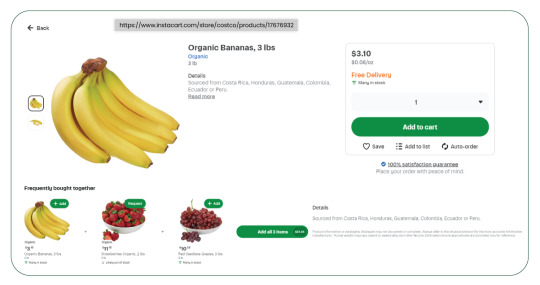
Product Full Name
Product SKU/Code
Image Product URL
Category of Product
Subcategories
Product Price
Discounted Price
Product Savings
Cost of Shipping
Description of Product
Specification of Product
Details Seller
Best Deals on Popular Products
Offer Best
Sellers Best
Offers Combo
Why Scrape Grocery Delivery Data?
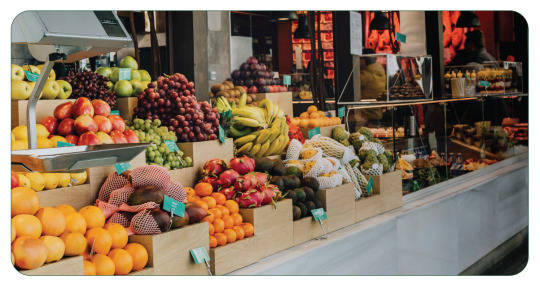
Scraping grocery delivery data offers numerous benefits for businesses and consumers:
Competitive Analysis: It allows businesses to gather competitors' data and analyze their pricing strategies, product offerings, and delivery services to gain a competitive edge.
Pricing Optimization: By scraping pricing data from various grocery delivery services, businesses can make informed pricing decisions to attract and retain customers.
Product Availability: Monitoring product availability and stock levels helps businesses meet customer demand and avoid stockouts.
Market Trends: Scrape grocery delivery data to provide insights into market trends, helping businesses adapt to changing consumer preferences and emerging product categories.
Customer Convenience: Consumers can use scraped data to compare grocery delivery options, find the best deals, and streamline their shopping experience, ultimately saving time and money.
How Can Grocery Data Scraping Help Enhance Business Success?
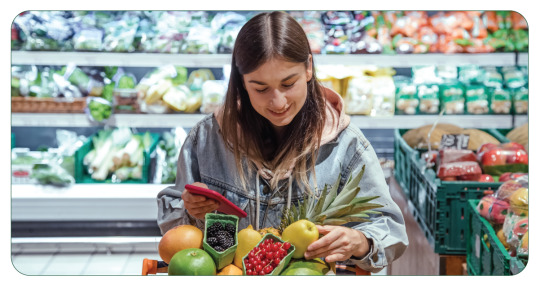
Grocery delivery data scraping is a potent catalyst for business success in the ever-evolving world of online grocery retail. Aggregating data from various sources equips businesses with the intelligence to make informed decisions that drive growth and competitiveness. It offers a competitive advantage by providing insights into pricing strategies, product assortments, and service offerings of rivals. Real-time pricing data enables businesses to optimize pricing strategies, attracting and retaining customers while ensuring profitability. Monitoring product availability and stock levels minimizes the risk of stockouts, ensuring a seamless customer experience. Insights into market trends and consumer preferences help businesses adapt staying ahead of changing demands. In addition, customer behavior analysis allows for tailored services, ultimately boosting customer satisfaction. Automating data collection using grocery data scraper saves time and resources, directing efforts toward strategic planning and operational efficiency. Whether expanding into new regions or diversifying product lines, grocery data scraping services empower businesses to make data-driven choices and enhance their prospects of success in the dynamic grocery sector. Web scraping grocery delivery data is a versatile tool with various applications, benefiting many stakeholders in the rapidly growing online grocery market. Whether you are an established grocery retailer, an online merchant, a bulk grocery dealer, a competitor in the grocery platform sector, or a business planning expansion, web scraping provides unique advantages:
Grocery Retailers: If you currently operate a brick-and-mortar grocery business, transitioning to an online model can provide customers with enhanced convenience. To ensure a successful transition, analyzing local competitors' offerings is crucial. Web scraping services can help you gain insights into local grocers' products, pricing, and strategies. This data can guide your marketing efforts and ensure a competitive edge when joining popular grocery delivery platforms.
Online Retailers: Incorporating groceries can boost sales and revenue for online retailers offering products across various categories. High-quality grocery items can attract a broader customer base, increasing sales in other product categories. Web scraping allows you to identify the most appealing grocery products and refine your offerings accordingly.
Bulk Grocery Dealers: If you are a bulk grocery dealer catering to retailers, web scraping can provide invaluable insights into customer preferences. Collecting data from product ratings and reviews can comprehensively understand popular product categories across different regions. This information helps you tailor your offerings to attract more retailers seeking bulk grocery supplies.
Grocery Platform Competitors: In an industry with regular new entrants, staying competitive is essential. Web scraping can significantly enhance your business strategy if you operate or plan to launch an online grocery platform. By scraping data from competitor platforms, you can gather critical insights into market dynamics, best-selling products, pricing strategies, and more. This valuable information gives your business a substantial competitive advantage.
Business Expansion: Expanding your grocery delivery services to new cities or regions requires thorough market research. A customized web scraping solution is instrumental in this process. By leveraging location-specific data, you can gain a detailed overview of existing grocery delivery services and sellers in the target area. This information allows you to align your expansion plans with local market expectations and requirements, increasing your chances of success.
Use Cases Of Grocery Delivery Data Scraping
Extracting grocery delivery data can offer consumers and businesses a wide range of valuable use cases. Here are these use cases explained in more detail:
Price Comparison: Grocery delivery data can be scraped from various sources to compare the prices of different products across multiple online retailers or local stores. It enables consumers to find the most cost-effective options for their groceries.
Product Research: Scraping data from grocery websites provides detailed information about grocery products, such as descriptions, nutritional facts, customer reviews, and ratings. This information empowers consumers to decide which products to buy, considering factors like quality and suitability for their needs.
Stock Availability: Consumers can scrape grocery data to check the real-time stock availability of products. It helps prevent disappointment by ensuring that the desired items are in stock before placing an order, which is particularly important for popular or seasonal items.
Shopping List Creation: Using scraped data, consumers can create customized shopping lists. They can browse available products, add them to their lists, and plan their grocery shopping more efficiently, ensuring they remember all essential items.
Price Tracking: Scraped data allows consumers to track price changes. It enables them to identify price drops, discounts, and the optimal time to purchase, saving money.
Market Analysis: For businesses, scraping grocery delivery data provides valuable insights into market trends, popular products, and customer preferences. This information is crucial for making strategic decisions and adjustments to meet market demands effectively.
Personalized Recommendations: Using scraped data, businesses, and online grocery platforms can offer personalized product recommendations to customers. These recommendations are based on individual preferences, past purchase history, and browsing behavior, enhancing the shopping experience.
Promotions and Marketing: Businesses can use scraped data to identify marketing opportunities and promotional strategies. This data helps target specific customer segments effectively and create marketing campaigns that resonate with their audience.
At Product Data Scrape, we maintain the highest ethical standards in all operations, including Competitor Price Monitoring Services and Mobile App Data Scraping. With a global presence spanning multiple offices, we consistently deliver exceptional and honest services to meet the diverse needs of our valued customers.
#GroceryDeliveryDataScraping#WebScrapingGroceryData#GroceryDataScraper#GroceryDataExtraction#ScrapeGroceryDeliveryData
0 notes